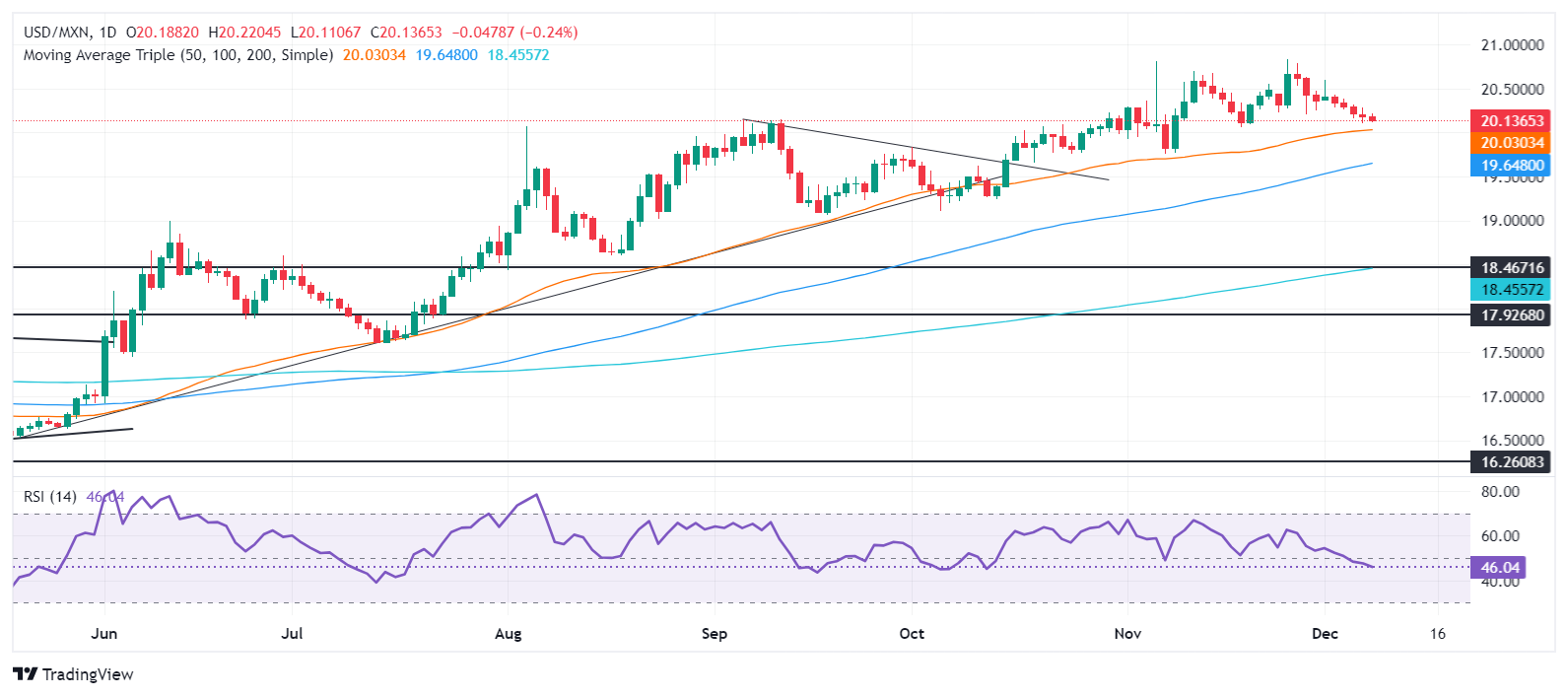- Mexican Peso loses some ground amid modest gains in the US Dollar.
- Banxico Governor adopts cautious stance on aggressive rate cuts despite lower inflation.
- Upcoming economic releases include Mexican Consumer Confidence and US CPI prior to the FOMC event next week.
The Mexican Peso gave up part of its recent rally on Monday, reacting to a slight rebound in the Greenback and a dip in Mexico’s inflation to its lowest level since April 2024. While this development hints that the Bank of Mexico (Banxico) could extend its easing cycle, USD/MXN printed acceptable gains beyond the 20.20 level as the US session drew to a close.
Mexico’s economic docket revealed that headline and core inflation in November missed estimates, edging lower after the Consumer Price Index (CPI) hit its highest level of 5.57% in July, according to the Instituto Nacional de Estadistica Geografia e Informatica (INEGI).
Last week, Banxico Governor Irene Espinosa was hawkish, saying, "At this point, too many things need to change to be able to believe that the conditions are right for a much more aggressive move." Her statement followed a query about the possibility of a cut of more than 25 points.
Across the border on Friday, the latest US Nonfarm Payrolls (NFP) report in November was stellar. The economy added 227K jobs to the workforce, exceeding estimates of 200K, though the Unemployment Rate ticked up from 4.1% to 4.2%.
Federal Reserve (Fed) officials have begun their blackout period before the December 17-18 monetary policy meeting. Policymakers failed to provide any hints regarding the meeting with most supporting a gradual approach. They are awaiting November’s Consumer Price Index (CPI) data on December 11.
This week, Mexico’s economic docket will feature Consumer Confidence and Industrial Production data. In the US, the Consumer Price Index, the Producer Price Index, and Initial Jobless Claims data will also entice traders.
Daily digest market movers: Mexican Peso gives away some of its recent gains
- Mexico’s headline inflation dipped from 4.76% to 4.55% YoY, below forecasts of 4.60%, its lowest level in eight months.
- Core figures showed an improvement of the disinflation process with November edging lower from 3.80% to 3.58%, below projections of 3.6%.
- “Mexican inflation continues to decline slightly and underlying pressures are under control. We believe that the headline CPI will increase by around 0.5% monthly in December, and that the annual rate will close 2024 at 4.4%,” explained Andrés Abadía, chief economist for LATAM at Pantheon Macroeconomics.
- Banco Base Economist Gabriela Siller said, "The Bank of Mexico is expected to cut interest rates by 25 basis points on Dec. 19. For 2025, inflation is expected to slow down to close the year at 4.1%, and the Bank of Mexico will cut the interest rate to 8.5%."
- Money market futures price in 90% odds that the Fed will lower borrowing costs by 25 basis points this month, according to the CME FedWatch Tool.
- Banxico’s November survey shows that analysts estimate Mexican inflation at 4.42% in 2024 and 3.84% in 2025. Underlying inflation figures will remain at 3.69% in 2024 and 2025. GDP is forecast at 1.55% and 1.23% for 2024 and 2025, respectively, and the USD/MXN exchange rate at 20.22 for the rest of the year and 20.71 in 2025.
Mexican Peso technical outlook: USD/MXN faces decent contention around 20.00
The USD/MXN dipped as low as 20.09 last Friday, near the 50-day Simple Moving Average (SMA) at 20.00. Momentum shifted to the downside as the Relative Strength Index (RSI) turned bearish, indicating that the exotic pair could test the 20.00 mark.
In that outcome, the next support would be the 100-day SMA at 19.61 before testing the psychological 19.50 mark, ahead of the 19.00 figure. Otherwise, if USD/MXN climbs above the December 6 high of 20.28, that could pave the way to challenge 20.50, ahead of the year-to-date peak at 20.82, followed by the 21.00 mark.
Inflation FAQs
Inflation measures the rise in the price of a representative basket of goods and services. Headline inflation is usually expressed as a percentage change on a month-on-month (MoM) and year-on-year (YoY) basis. Core inflation excludes more volatile elements such as food and fuel which can fluctuate because of geopolitical and seasonal factors. Core inflation is the figure economists focus on and is the level targeted by central banks, which are mandated to keep inflation at a manageable level, usually around 2%.
The Consumer Price Index (CPI) measures the change in prices of a basket of goods and services over a period of time. It is usually expressed as a percentage change on a month-on-month (MoM) and year-on-year (YoY) basis. Core CPI is the figure targeted by central banks as it excludes volatile food and fuel inputs. When Core CPI rises above 2% it usually results in higher interest rates and vice versa when it falls below 2%. Since higher interest rates are positive for a currency, higher inflation usually results in a stronger currency. The opposite is true when inflation falls.
Although it may seem counter-intuitive, high inflation in a country pushes up the value of its currency and vice versa for lower inflation. This is because the central bank will normally raise interest rates to combat the higher inflation, which attract more global capital inflows from investors looking for a lucrative place to park their money.
Formerly, Gold was the asset investors turned to in times of high inflation because it preserved its value, and whilst investors will often still buy Gold for its safe-haven properties in times of extreme market turmoil, this is not the case most of the time. This is because when inflation is high, central banks will put up interest rates to combat it. Higher interest rates are negative for Gold because they increase the opportunity-cost of holding Gold vis-a-vis an interest-bearing asset or placing the money in a cash deposit account. On the flipside, lower inflation tends to be positive for Gold as it brings interest rates down, making the bright metal a more viable investment alternative.
Information on these pages contains forward-looking statements that involve risks and uncertainties. Markets and instruments profiled on this page are for informational purposes only and should not in any way come across as a recommendation to buy or sell in these assets. You should do your own thorough research before making any investment decisions. FXStreet does not in any way guarantee that this information is free from mistakes, errors, or material misstatements. It also does not guarantee that this information is of a timely nature. Investing in Open Markets involves a great deal of risk, including the loss of all or a portion of your investment, as well as emotional distress. All risks, losses and costs associated with investing, including total loss of principal, are your responsibility. The views and opinions expressed in this article are those of the authors and do not necessarily reflect the official policy or position of FXStreet nor its advertisers. The author will not be held responsible for information that is found at the end of links posted on this page.
If not otherwise explicitly mentioned in the body of the article, at the time of writing, the author has no position in any stock mentioned in this article and no business relationship with any company mentioned. The author has not received compensation for writing this article, other than from FXStreet.
FXStreet and the author do not provide personalized recommendations. The author makes no representations as to the accuracy, completeness, or suitability of this information. FXStreet and the author will not be liable for any errors, omissions or any losses, injuries or damages arising from this information and its display or use. Errors and omissions excepted.
The author and FXStreet are not registered investment advisors and nothing in this article is intended to be investment advice.
Recommended content
Editors’ Picks

Gold moves to record highs past $3,340
Gold now gathers extra steam and advances beyond the $3,340 mark per troy ounce on Wednesday, hitting all-time highs amid ongoing worries over escalating US-China trade tensions, a weaker US Dollar and lack of news from Powell's speech.

AUD/USD: Upside now refocuses the 200-day SMA
AUD/USD advanced for the sixth consecutive daily advance, picking up extra upside impulse on the back of the continuation of the sell-off in the US Dollar. Next on tap for the Aussie now emerges the yearly peak above 0.6400 prior to the key 200-day SMA.

EUR/USD looks to retest its 2025 highs
EUR/USD reversed two consecutive daily retracements and revisited the key 1.1400 neighbourhood as the selling bias in the Greenback gathered extra pace, always against the backdrop of rising uncertainty surrounding US yields. Chief Powell, in the meantime, delivered a neutral message in his discussion over the economic outlook.

Bitcoin held steady as US reveals China faces up to 245% tariffs
Bitcoin (BTC) witnessed little pressure on Wednesday despite the Chinese government selling off parts of its confiscated cryptocurrency holdings.

Future-proofing portfolios: A playbook for tariff and recession risks
It does seem like we will be talking tariffs for a while. And if tariffs stay — in some shape or form — even after negotiations, we’ll likely be talking about recession too. Higher input costs, persistent inflation, and tighter monetary policy are already weighing on global growth.

The Best brokers to trade EUR/USD
SPONSORED Discover the top brokers for trading EUR/USD in 2025. Our list features brokers with competitive spreads, fast execution, and powerful platforms. Whether you're a beginner or an expert, find the right partner to navigate the dynamic Forex market.




